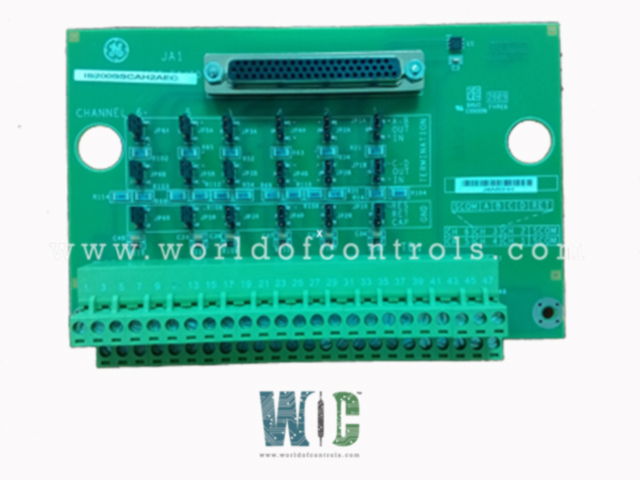SPECIFICATIONS
Part No.: IS200SSCAH2AGB
Manufacturer: General Electric
Country of Manufacture: USA
Size: 15.9 cm high x 10.2 cm wide
Maximum drops: Eight drops max
Technology: Surface-mount
Temperature Operating: -30 to 65oC
Product Type: Serial Communication I/O Terminal Board
Availability: In Stock
Series: Mark VIe
Functional Description
IS200SSCAH2AGB is a Serial Communication I/O Terminal Board developed by GE. It is a part of Mark VIe control system. The Simplex Serial Communication Input/Output (SSCA) terminal board facilitates in seamless serial communication within the systems. The terminal board boasts a compact design, optimizing space utilization while offering unparalleled functionality. Despite its small footprint, it accommodates up to six communication channels, ensuring versatility and adaptability to diverse communication requirements within the system.
Features
- Flexible Configuration: Each communication channel on the board is highly configurable, supporting multiple signaling standards including RS-232C, RS-485, or RS-422. This flexibility empowers system integrators to tailor communication protocols according to specific application needs, enhancing compatibility and interoperability across various devices and components.
- Solely Simplex: The board is exclusively available in a simplex version, streamlining deployment and operation within the system architecture. This ensures consistency and simplifies configuration, eliminating complexities associated with managing duplex communication modes.
- High-Density Terminal Blocks: Facilitating robust connections, the board features high-density Euro-style box type terminal blocks. These terminal blocks provide secure and reliable connections for communication channels, minimizing signal loss and ensuring optimal performance even in demanding operating environments.
Installation
- Mounting Configuration: Designed for versatile mounting options, providing flexibility to suit various installation environments. It is typically mounted on a DIN-rail using a sheet metal carrier and plastic insulator mount. This mounting configuration ensures secure attachment while minimizing installation time and effort. Additionally, the assembly can be directly bolted into a cabinet, offering an alternative installation method for specific requirements.
- Terminal Block Options: Two types of Euro-Block terminal blocks are available to accommodate different connectivity needs. The first type features a right-angle header capable of accepting a wide range of commercially available pluggable terminal blocks. With 48 terminals, this terminal block variant offers ample connectivity options, enabling versatile configuration and accommodating diverse communication requirements within the system.
- Euro-Block Terminal Blocks:The Euro-Block terminal blocks serve as the interface for establishing connections with external devices and communication channels. These terminal blocks ensure robust and reliable electrical connections, facilitating seamless communication between the SSCA board and peripheral devices. The right-angle header design enhances accessibility and ease of connection, simplifying installation and maintenance procedures.
- Secure Attachment: During installation, emphasis is placed on ensuring secure attachment of the board and terminal blocks. The DIN-rail mounting system, combined with the sheet metal carrier and plastic insulator mount, provides a stable foundation for the board within the cabinet or enclosure. This secure attachment minimizes the risk of displacement or damage, enhancing the overall reliability and longevity of the installation.
Configuration
- Jumpers for Termination Resistors: The terminal board features jumpers JP1A through JP6A and JP1B through JP6B, which facilitate the application or removal of termination resistors between signal lines A and B, as well as between signal lines C and D, respectively, for each of the six serial communication channels. These termination resistors play a crucial role in impedance matching and signal integrity, particularly in environments where signal reflections and noise are prevalent. By adjusting the jumper settings, system integrators can optimize communication performance and reliability based on the unique characteristics of the installation environment.
- Jumpers for Return Connection: Additionally, jumpers JP1R through JP6R enable the selection of the return connection type between the terminal board and the SCOM (Serial Communication Module). These jumpers allow for the configuration of either a resistive or capacitive connection for the return path. The choice between resistive and capacitive connections depends on various factors such as signal attenuation, noise immunity, and system requirements. By selecting the appropriate jumper settings, system designers can fine-tune the return connection to achieve optimal communication performance and signal stability.
The WOC team is always available to help you with your Mark VIe requirements. For more information, please contact WOC.
Frequently Asked Questions
What is IS200SSCAH2AGB?
It is a serial communication I/O terminal board developed by GE under the Mark VIe series.
What happens if there is a mismatch detected by the PSCA I/O pack during interrogation?
In the event of a mismatch between the information retrieved from the ID device and the expected parameters, the PSCA I/O pack generates a hardware incompatibility fault. This fault indicates a discrepancy between the terminal board and the system's expectations, prompting further investigation and corrective action to resolve the issue.
Can the information stored on the ID device be modified or altered?
No, the ID device is a read-only chip, meaning its contents cannot be modified or altered. It is encoded with fixed information during manufacturing, including the terminal board's serial number, type, revision number, and connector location. This ensures the integrity and authenticity of the identification data.
How does the hardware incompatibility fault impact system operation?
The hardware incompatibility fault serves as an alert mechanism, indicating a potential issue with the terminal board's compatibility within the system. When triggered, it prompts system administrators or technicians to investigate and rectify the mismatch to ensure proper functionality and performance of the system.
